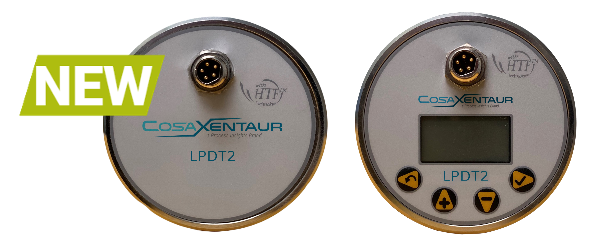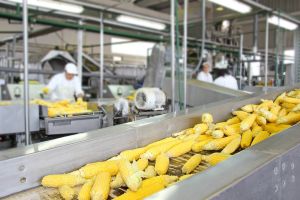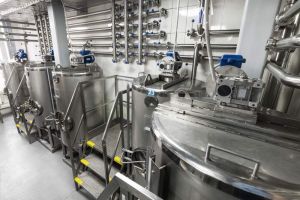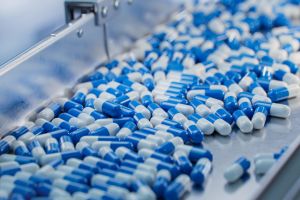LPDT2 SERIES
Dew Point Transmitter with Aluminum Oxide Sensor
Ultra-Compact DEW POINT Transmitter
Our NEW COSA XENTAUR™ LPDT2™ Series Low Pressure Dew Point Transmitter is ultra-compact, and loop-powered (two-wire). It comes with or without a display. LPDT2 Series Low Pressure Dew Point Transmitter with display is a fully functional instrument operated through a miniature custom LCD display and four push buttons, using the same user-friendly interface as all our hygrometers. Where a display at the point of measurement is not necessary, the LPDT2 is the answer. Modbus, and Analog outputs provide a simple and cost-efficient solution with trusted results.

The Model LPDT2 replaces the LPDT configurations and certifications listed below.
General Purpose Models:
- LPDT2 -65 Non-Display
- LPDT2 – 65 Display
- LPDT2 – 100 Non-Display
Hazardous Area Certified Models:
- LPDT2 – 100 Display
- LPDT2 -65 Non-Display Certified
- LPDT2 – 65 Display Certified
- LPDT2 – 100 Non-Display Certified
- LPDT2 – 100 Display Certified
Our LPDT2 Series Low Pressure Dew Point Transmitter is a highly accurate and reliable instrument designed for measuring dew point temperature in industrial applications. The LPDT2 uses a thin-film aluminum oxide sensor to provide accurate and stable measurements of dew point temperature, which is a key indicator of moisture content.
Some key features of our LPDT2 Series Low Pressure Dew Point Transmitter:
- High accuracy: Designed to provide highly accurate measurements of dew point temperature, with an accuracy of ±1.8°F (±1°C).
- Wide measuring range: Can measure dew points from as low as -148°F (-100°C) to as high as 68°F (20°C), making it suitable for a wide range of industrial applications.
- Fast response time: Provides quick and real-time measurements, which is crucial for process control and optimization.
- Stable and reliable: The aluminum oxide sensor used in the LPDT2™ is highly stable and reliable, with a long lifespan and low maintenance requirements.
- Resistant to contamination: The aluminum oxide sensor is highly resistant to contamination from oils, fuels, and other substances that can interfere with measurements.
- User-friendly: Designed to be user-friendly, with an intuitive interface and easy installation and calibration.
- Versatile: Can be used to measure the moisture content of various gases and liquids, including natural gas, compressed air, hydrogen, nitrogen, and more.
INDUSTRIES
Some of the industries that use the LPDT2 Series Low Pressure Dew Point Transmitter include:
- Compressed air systems: Used to monitor the dew point of compressed air to ensure the quality of the air and prevent corrosion in the system.
- Refrigeration and air conditioning: The accurate measurement of dew point is important for the proper functioning of refrigeration and air conditioning systems.
- Industrial drying: Used to monitor the moisture content in industrial drying processes to ensure product quality and consistency.
- Pharmaceuticals and biotech: The measurement of dew point is critical in pharmaceutical and biotech manufacturing processes to ensure the quality and safety of the products.
- Petrochemical production: The accurate measurement of dew point is important for quality control and safety in petrochemical production processes.
- Power generation: Used in power generation to monitor the moisture content in hydrogen gas, which is important for safety and preventing corrosion.
TWO TRANSMITTER VERSIONS AVAILABLE
- A transmitter with no display (blind) with HTF aluminum oxide sensors without the additional expense of on-board transmitter control
- A transmitter with a NEW 4 button display will provide users with even more control than the original LPDT (3 button unit). View, select and set options within the transmitter.
CONFIGURATIONS
- LPDT2-100 – general purpose and CL1 Div 2
- LPDT2-B100 – general purpose and CL1 Div 2
- LPDT2-65 – general purpose and CL1 Div 2
- LPDT2-B65 – general purpose and CL1 Div 2
FEATURES
- Loop Powered, with 4-20mA analog output
- Data Logging outputs via MODBUS 485
- User Selectable Settings for units of measure
- 3 Field Adjustment options
- NEMA 4 IP66 Housing
- Display unit can be rotated to read upright
- Optional Cl 1 Div 2 area rating (coming soon)
- Integrated HTF™ Sensor Technology
- Display and no-display version available
- Low-cost and easy maintenance
- Weatherproof NEMA 4X IP66
- Convenient logging feature
- RS-485 Modbus Interface
- Adjustable analog outputs
- Very low drift
- Long sensor life
APPLICATIONS
- Glove boxes
- Clean room environments
- Natural gas transmission
- Hydrocarbon processing
- Air dryers and compressors
- Specialty air gases
- Cryogenic
- Air generators
SOLUTIONS FLYERS
-

AGRICULTURE
-

CHEMICAL
-

ENERGY
-

FOOD & BEVERAGE
-

FLARE GAS
-

INDUSTRIAL GAS
-


LAB & RESEARCH
-


PHARMACEUTICALS & LIFE SCIENCE
-


REFINERY
-


SEMICONDUCTOR
-



SPECIALTY GAS

















